Autogenous Healing of Early-Age Cracks in Cementitious Materials by Superabsorbent Polymers
Abstract
:1. Introduction
2. Materials and Methods
2.1. Materials
2.2. Samples
2.3. Test Methods
2.3.1. Water Flow Test and Microscopy
2.3.2. Test on the Recovery of Compressive Strength
- Three specimens were tested to evaluate the initial 7-day compressive strength (fc(7));
- The remaining nine specimens were pre-damaged using a stress equal to 80% of fc(7) to obtain a preset damage level;
- Three pre-damaged specimens were re-tested up to failure immediately after pre-cracking, obtaining the compressive strength (f *c(7));
- The remaining six pre-damaged specimens were re-tested up to the maximum achievable compressive strength after curing under the two different healing conditions, obtaining (f *c(7+28)).
2.3.3. Characterization of the Healing Products
3. Experimental Results and Discussion
3.1. Water Flow through Cracks
3.2. Surface Crack Closure Test
3.3. Compressive Strength Recovery
3.4. SEM and FT-IR Results
4. Conclusions
- The incorporation of SAPs in cementitious materials with early-age cracking can achieve rapid crack self-sealing in the short term, and also long-term improvements in autogenous crack healing.
- Based on the water flow test results, it is considered that the incorporation of 1.0% SAP can completely block the low-pressure water flowing through cracks over time by approximately less than 300 µm in early-age cementitious materials.
- The flow rates in the first hour of the water flow test varied much more for the CP/CM–S–0.5 and CP/CM–S–1.0 specimens than for the CP/CM–R specimens (without SAPs), as cracks were rapidly sealed due to rapid swelling of the SAPs in the cracks as they absorbed water.
- Water flow tests showed that autogenous crack healing occurred to some extent in the samples without SAPs due to further hydration of the un-hydrated cement particles, although the efficiency of crack healing was greatly improved in the presence of SAPs.
- During the 28-d water flow test, the mean flow rates through the CP–S and CM–S specimens decreased much more than those of the CP–R and CM–R specimens, while the reduction ratio increased with increasing SAP dosage.
- The autogenous crack healing efficiency of the CP–R and CM–R specimens improved when exposed to wet conditions compared to wet/dry conditions, while the opposite was true for CP–S and CM–S specimens.
- When the cracked SAP-containing specimens were exposed to wet/dry conditions, healing products tended to concentrate within the internal cracks.
- Swelling of SAP particles formed multiple voids in the CM, which decreased the initial 7-d compressive strength with increasing SAP dosage. However, the compressive strengths of the pre-cracked SAP-containing specimens after the 28-d healing period increased significantly compared to immediately after pre-cracking. This was attributed to enhanced autogenous healing by the SAPs. The highest ISR was observed for the CM–S–1.0B specimen (37 ± 4%), which is a very high strength recovery rate. This result represents that the mechanical degradation due to the incorporation of SAPs can be solved considerably.
- The major healing products formed by the SAPs were CaCO3 and CSH, which were formed along the surface of voids formed by swollen SAPs when immersed in water, and enhanced by wet/dry cyclic conditions due to the internal curing effect of the SAPs.
Author Contributions
Funding
Conflicts of Interest
References
- Wang, H.L.; Dai, J.G.; Sun, X.Y.; Zhang, X.L. Characteristics of concrete cracks and their influence on chloride penetration. Constr. Build. Mater. 2016, 107, 216–225. [Google Scholar] [CrossRef]
- Otieno, M.; Beushausen, H.; Alexander, M. Chloride-induced corrosion of steel in cracked concrete—Part I: Experimental studies under accelerated and natural marine environments. Cem. Concr. Res. 2016, 79, 373–385. [Google Scholar] [CrossRef]
- Edvardsen, C. Water permeability and autogenous healing of cracks in concrete. ACI Mater. J. 1999, 96, 448–454. [Google Scholar]
- Yang, Y.; Lepech, M.D.; Yang, E.H.; Li, V.C. Autogenous healing of engineered cementitious composites under wet–dry cycles. Cem. Concr. Res. 2009, 39, 382–390. [Google Scholar] [CrossRef]
- Ahn, T.H.; Kishi, T. Crack self-healing behavior of cementitious composites incorporating various mineral admixtures. J. Adv. Concr. Technol. 2010, 8, 171–186. [Google Scholar] [CrossRef] [Green Version]
- Van Tittelboom, K.; Gruyaert, E.; Rahier, H.; De Belie, N. Influence of mix composition on the extent of autogenous crack healing by continued hydration or calcium carbonate formation. Constr. Build. Mater. 2012, 37, 349–359. [Google Scholar] [CrossRef]
- Snoeck, D.; De Belie, N. From straw in bricks to modern use of microfibers in cementitious composites for improved autogenous healing–A review. Constr. Build. Mater. 2015, 95, 774–787. [Google Scholar] [CrossRef]
- Sisomphon, K.; Copuroglu, O.; Koenders, E.A.B. Self-healing of surface cracks in mortars with expansive additive and crystalline additive. Cem. Concr. Compos. 2012, 34, 566–574. [Google Scholar] [CrossRef]
- Coppola, L.; Coffetti, D.; Crotti, E. Innovative carboxylic acid waterproofing admixture for self-sealing watertight concretes. Constr. Build. Mater. 2018, 171, 817–824. [Google Scholar] [CrossRef]
- Meng, W.; Khayat, K. Effects of saturated lightweight sand content on key characteristics of ultra-high-performance concrete. Cem. Concr. Res. 2017, 101, 46–54. [Google Scholar] [CrossRef]
- Zohuriaan-Mehr, M.J.; Omidian, H.; Doroudiani, S.; Kabiri, K. Advances in non-hygienic applications of superabsorbent hydrogel materials. J. Mater. Sci. 2010, 45, 5711–5735. [Google Scholar] [CrossRef]
- Kim, D.; Park, K. Swelling and mechanical properties of superporous hydrogels of poly (acrylamide-co-acrylic acid)/polyethylenimine interpenetrating polymer networks. Polymer 2004, 45, 189–196. [Google Scholar] [CrossRef]
- Jensen, O.M.; Hansen, P.F. Water-entrained cement-based materials: I. Principles and theoretical background. Cem. Concr. Res. 2001, 31, 647–654. [Google Scholar] [CrossRef]
- Jensen, O.M.; Hansen, P.F. Water-entrained cement-based materials II. Experimental observations. Cem. Concr. Res. 2002, 32, 973–978. [Google Scholar] [CrossRef]
- Song, C.; Choi, Y.C.; Choi, S. Effect of internal curing by superabsorbent polymers—Internal relative humidity and autogenous shrinkage of alkali-activated slag mortars. Constr. Build. Mater. 2016, 123, 193–206. [Google Scholar] [CrossRef]
- Lyu, Z.; Guo, Y.; Chen, Z.; Shen, A.; Qin, X.; Yang, J.; Zhao, J.; Wang, Z. Research on shrinkage development and fracture properties of internal curing pavement concrete based on humidity compensation. Constr. Build. Mater. 2019, 203, 417–431. [Google Scholar] [CrossRef]
- He, Z.; Shen, A.; Guo, Y.; Lyu, Z.; Li, D.; Qin, X.; Zhao, M.; Wang, Z. Cement-based materials modified with superabsorbent polymers: A review. Constr. Build. Mater. 2019, 225, 569–590. [Google Scholar] [CrossRef]
- Hong, G.; Choi, S. Rapid self-sealing of cracks in cementitious materials incorporating superabsorbent polymers. Constr. Build. Mater. 2017, 143, 366–375. [Google Scholar] [CrossRef]
- Hong, G.; Choi, S. Modeling rapid self-sealing of cracks in cementitious materials using superabsorbent polymers. Constr. Build. Mater. 2018, 164, 570–578. [Google Scholar] [CrossRef]
- Hong, G.; Song, C.; Park, J.; Choi, S. Hysteretic behavior of rapid self-sealing of cracks in cementitious materials incorporating superabsorbent polymers. Constr. Build. Mater. 2019, 195, 187–197. [Google Scholar] [CrossRef]
- Snoeck, D.; Van Tittelboom, K.; Steuperaert, S.; Dubruel, P.; De Belie, N. Self-healing cementitious materials by the combination of microfibres and superabsorbent polymers. J. Intell. Mater. Syst. Struct. 2014, 25, 13–24. [Google Scholar] [CrossRef] [Green Version]
- Park, B.; Choi, Y.C. Self-healing capability of cementitious materials with crystalline admixtures and super absorbent polymers (SAPs). Constr. Build. Mater. 2018, 189, 1054–1066. [Google Scholar] [CrossRef]
- Huang, H.; Ye, G.; Damidot, D. Characterization and quantification of self-healing behaviors of microcracks due to further hydration in cement paste. Cem. Concr. Res. 2013, 52, 71–81. [Google Scholar] [CrossRef]
- Lee, H.X.D.; Wong, H.S.; Buenfeld, N.R. Self-sealing of cracks in concrete using superabsorbent polymers. Cem. Concr. Res. 2016, 79, 194–208. [Google Scholar] [CrossRef] [Green Version]
- Snoeck, D.; De Belie, N. Repeated autogenous healing in strain-hardening cementitious composites by using superabsorbent polymers. J. Mater Civ. Eng. 2015, 28, 1–11. [Google Scholar] [CrossRef] [Green Version]
- Snoeck, D.; Dewanckele, J.; Cnudde, V.; De Belie, N. X-ray computed microtomography to study autogenous healing of cementitious materials promoted by superabsorbent polymers. Cem. Concr. Compos. 2016, 65, 83–93. [Google Scholar] [CrossRef]
- Springenschmid, R. Prevention of Thermal Cracking in Concrete at Early Ages; E&FN Spon: New York, NY, USA, 1998. [Google Scholar]
- Shim, Y.; Hong, G.; Choi, S. Autogenous Healing of Early-Age Cementitious Materials Incorporating Superabsorbent Polymers Exposed to Wet/Dry Cycles. Materials 2018, 11, 2476. [Google Scholar] [CrossRef] [Green Version]
- Liu, J.; Shi, C.; Ma, X.; Khayat, K.H.; Zhang, J.; Wang, D. An overview on the effect of internal curing on shrinkage of high performance cement-based materials. Constr. Build. Mater. 2017, 146, 702–712. [Google Scholar] [CrossRef] [Green Version]
- Soliman, A.M.; Nehdi, M.L. Effect of partially hydrated cementitious materials and superabsorbent polymer on early-age shrinkage of UHPC. Constr. Build. Mater. 2013, 41, 270–275. [Google Scholar] [CrossRef]
- Snoeck, D.; Schroefl, C.; Mechtcherine, V. Recommendation of RILEM TC 260-RSC: Testing sorption by superabsorbent polymers (SAP) prior to implementation in cement-based materials. Mater. Struct. 2018, 51, 116. [Google Scholar] [CrossRef]
- Mechtcherine, V.; Snoeck, D.; Schröfl, C.; De Belie, N.; Klemm, A.J.; Ichimiya, K.; Moon, J.; Wyrzykowski, M.; Lura, P.; Toropovs, N.; et al. Testing superabsorbent polymer (SAP) sorption properties prior to implementation in concrete: Results of a RILEM Round-Robin Test. Mater. Struct. 2018, 51, 28. [Google Scholar] [CrossRef]
- Peppas, N.A.; Bures, P.; Leobandung, W.S.; Ichikawa, H. Hydrogels in pharmaceutical formulations. Eur. J. Pharm. Biopharm. 2000, 50, 27–46. [Google Scholar] [CrossRef]
- Gartner, E.M.; Tang, F.J.; Weiss, S.J. Saturation factors for calcium hydroxide and calcium sulfates in fresh Portland cement pastes. J. Am. Ceram. Soc. 1985, 68, 667–673. [Google Scholar] [CrossRef]
- Wang, F.; Yang, J.; Cheng, H.; Wu, J.; Liang, X. Study on mechanism of desorption behavior of saturated superabsorbent polymers in concrete. ACI Mater. J. 2015, 112, 463–470. [Google Scholar] [CrossRef]
- Lee, H.X.D.; Wong, H.S.; Buenfeld, N.R. Effect of alkalinity and calcium concentration of pore solution on the swelling and ionic exchange of superabsorbent polymers in cement paste. Cem. Concr. Compos. 2018, 88, 150–164. [Google Scholar] [CrossRef]
- Schweins, R.; Huber, K. Collapse of sodium polyacrylate chains in calcium salt solutions. Eur. Phys. J. E. 2001, 5, 117–126. [Google Scholar] [CrossRef]
- Akhavan, A.; Rajabipour, F. Quantifying the effects of crack width, tortuosity, and roughness on water permeability of cracked mortars. Cem. Concr. Res. 2012, 42, 313–320. [Google Scholar] [CrossRef]
- De Nardi, C.; Bullo, S.; Ferrara, L.; Ronchin, L.; Vavasori, A. Effectiveness of crystalline admixtures and lime/cement coated granules in engineered self-healing capacity of lime mortars. Mater. Struct. 2017, 50, 191. [Google Scholar] [CrossRef]
- Jiang, Z.; Li, W.; Yuan, Z. Influence of mineral additives and environmental conditions on the self-healing capabilities of cementitious materials. Cem. Concr. Compos. 2015, 57, 116–127. [Google Scholar] [CrossRef]
- Farzanian, K.; Ghahremaninezhad, A. Desorption of superabsorbent hydrogels with varied chemical compositions in cementitious materials. Mater. Struct. 2018, 51, 3. [Google Scholar] [CrossRef]
- Mignon, A.; Snoeck, D.; Schaubroeck, D.; Luickx, N.; Dubruel, P.; Van Vlierberghe, S.; De Belie, N. pH-responsive superabsorbent polymers: A pathway to self-healing of mortar. React. Funct. Polym. 2015, 93, 68–76. [Google Scholar] [CrossRef]
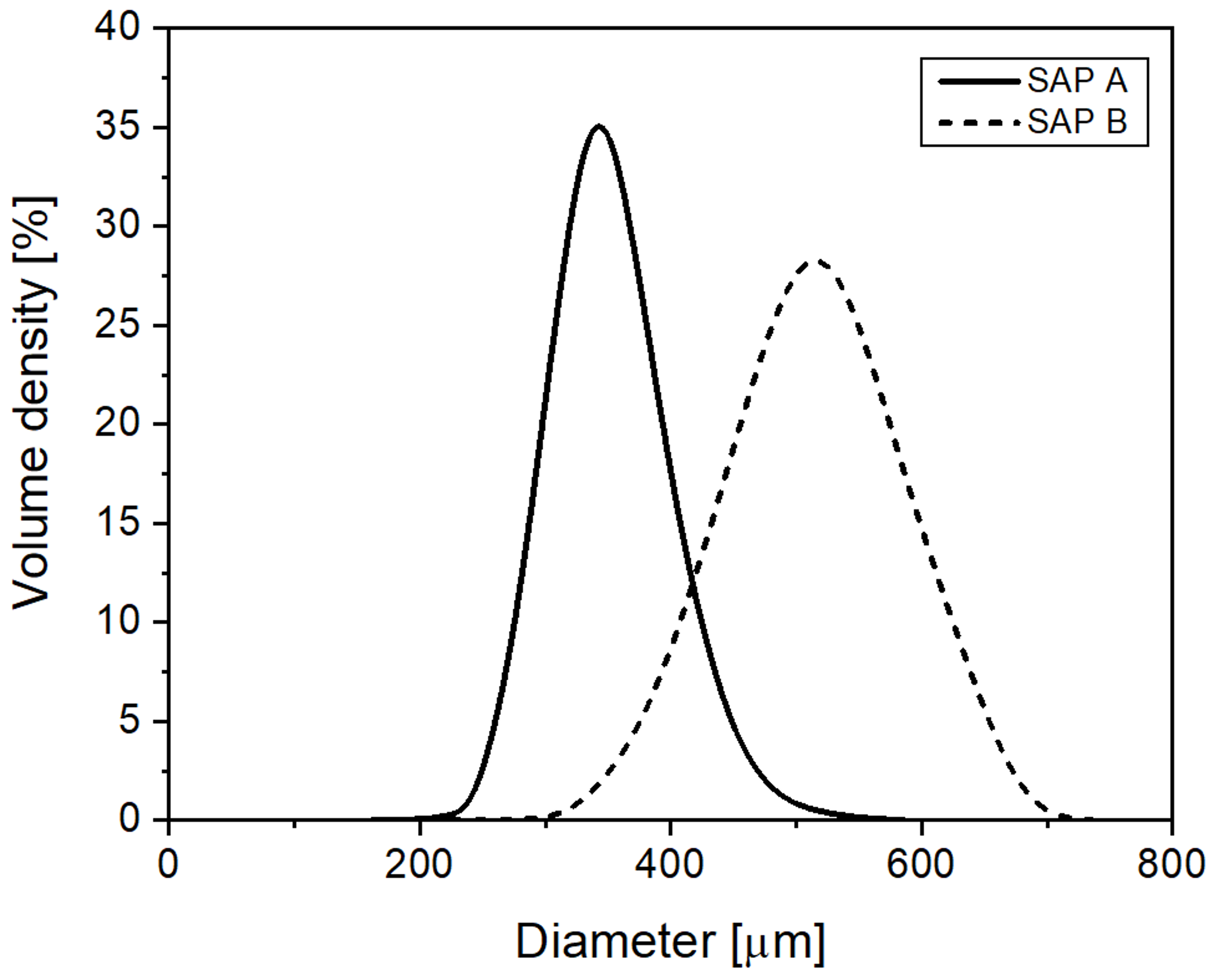
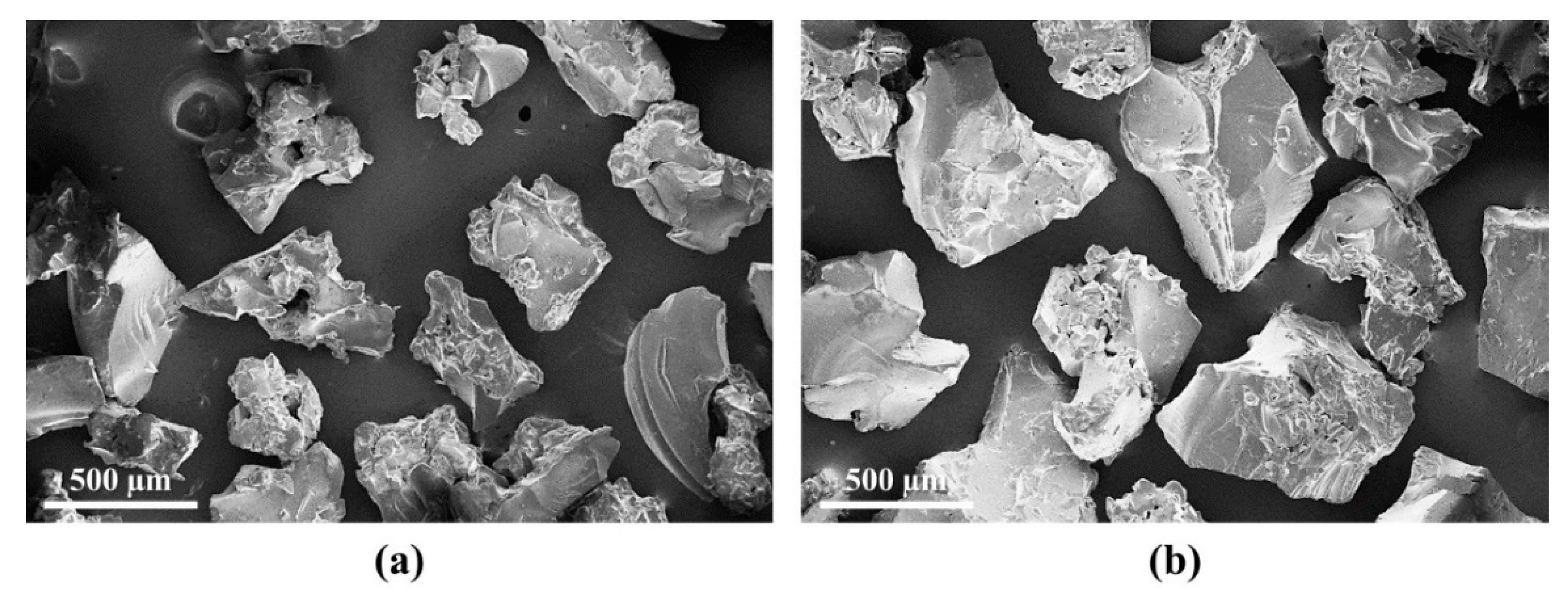
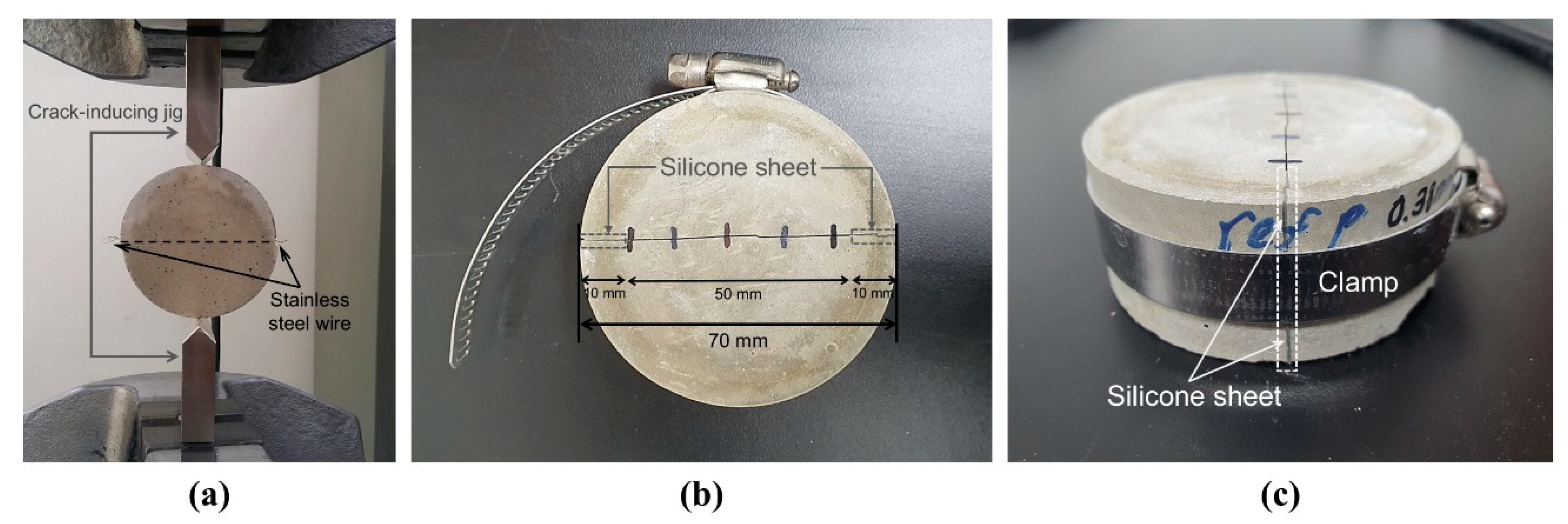
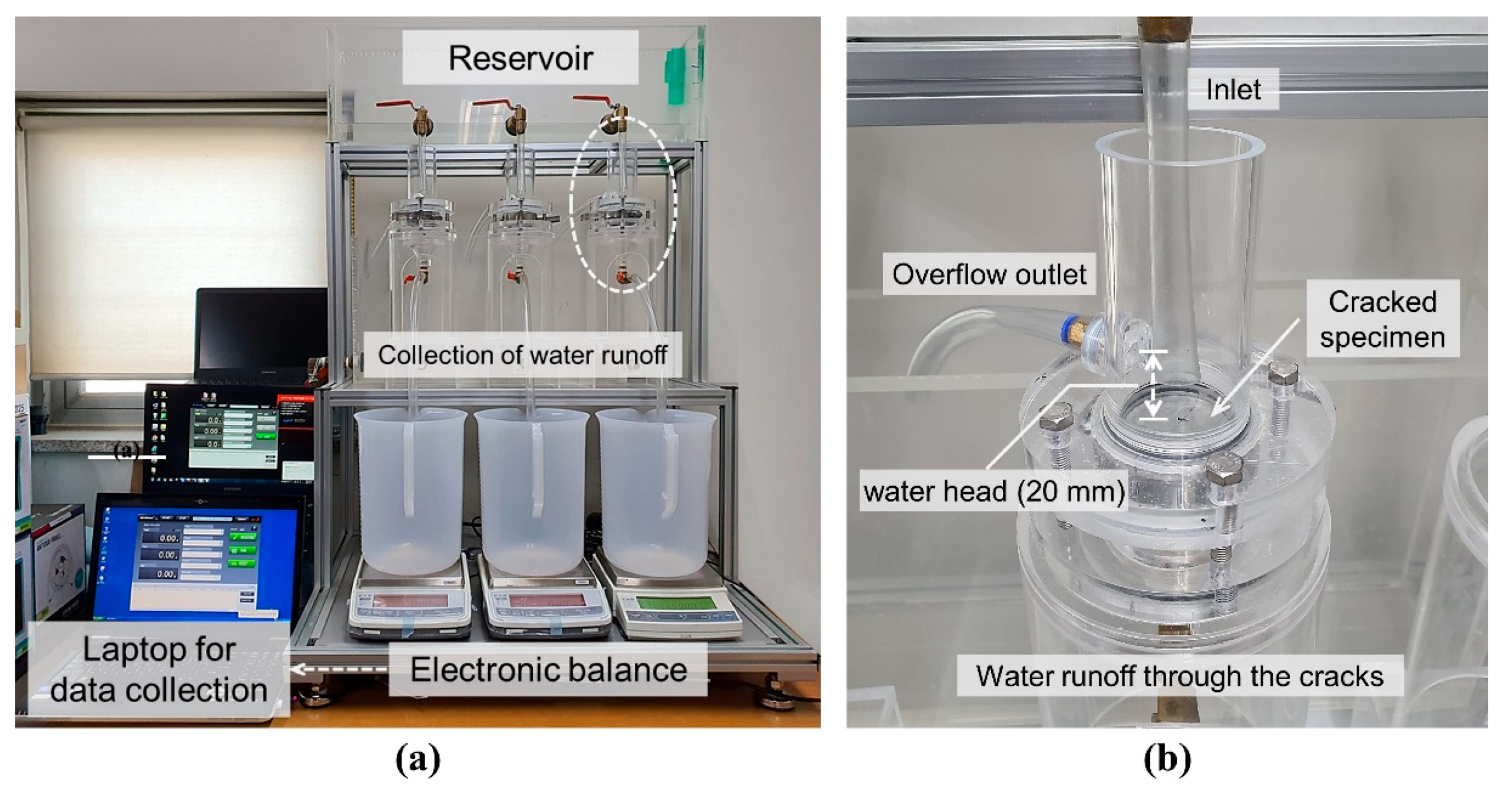

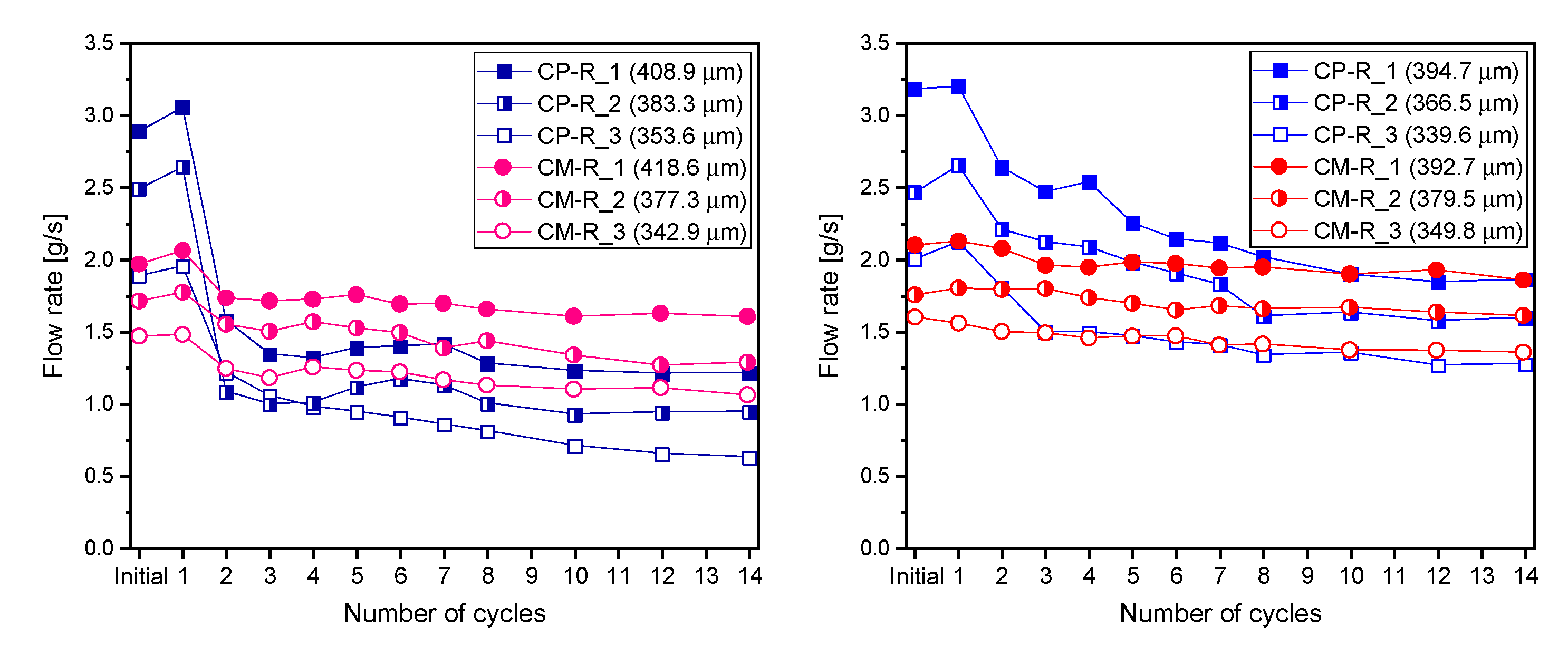


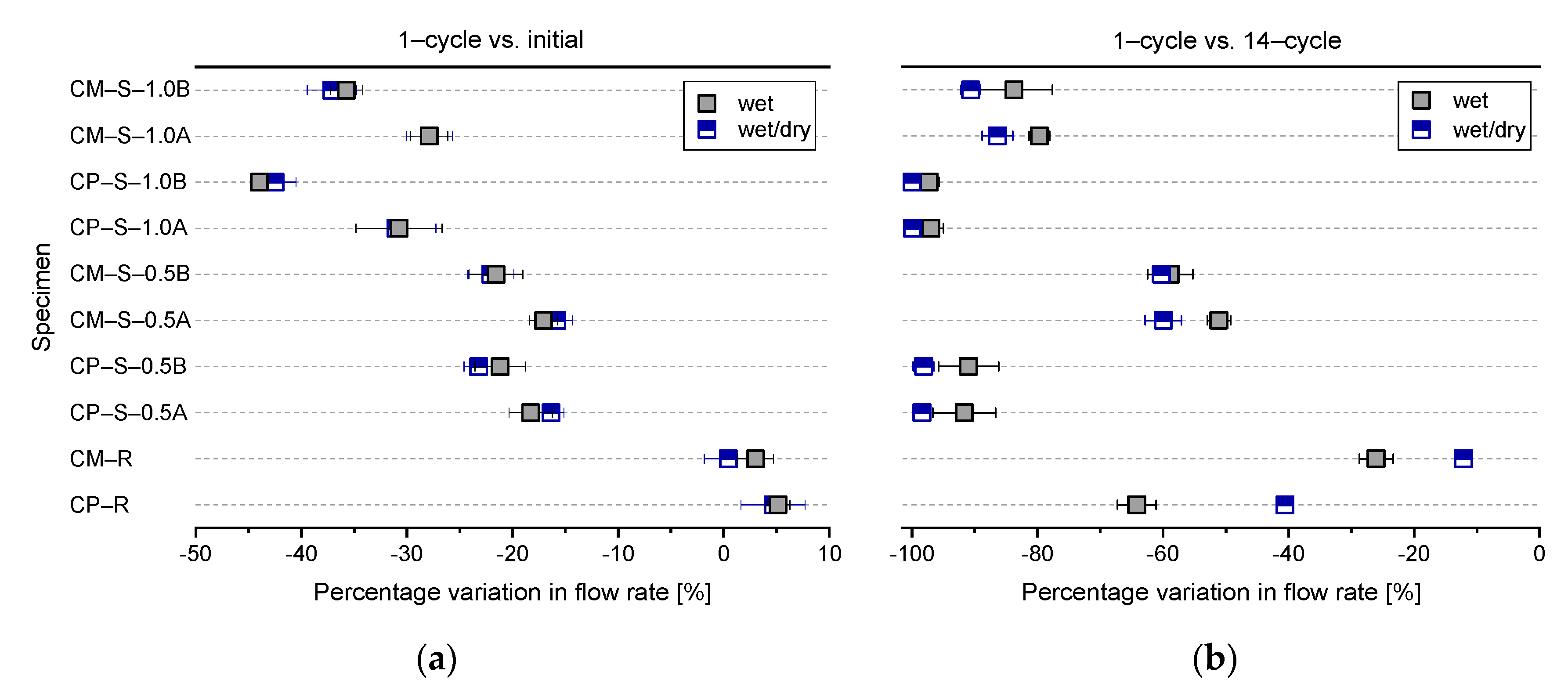
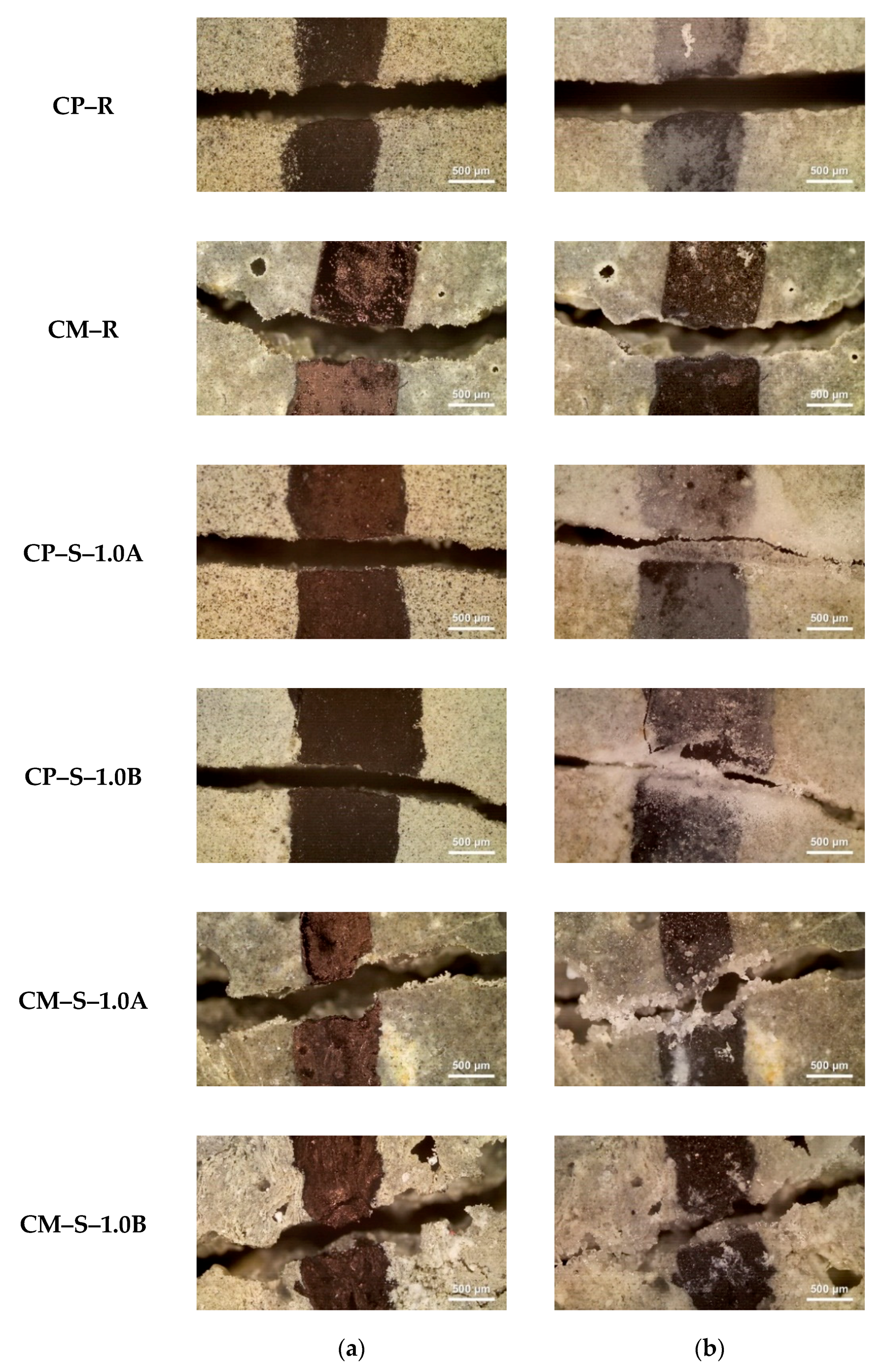


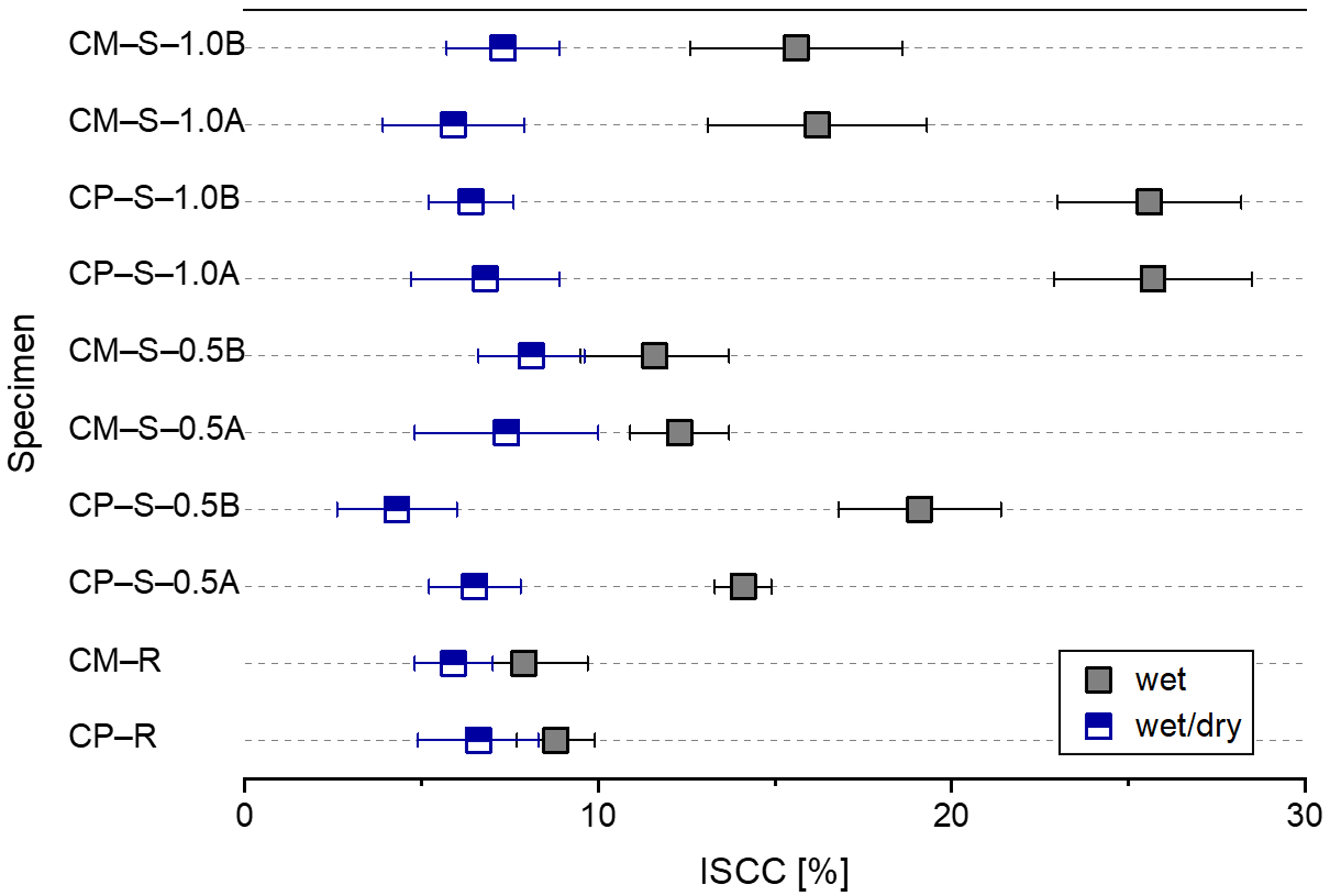
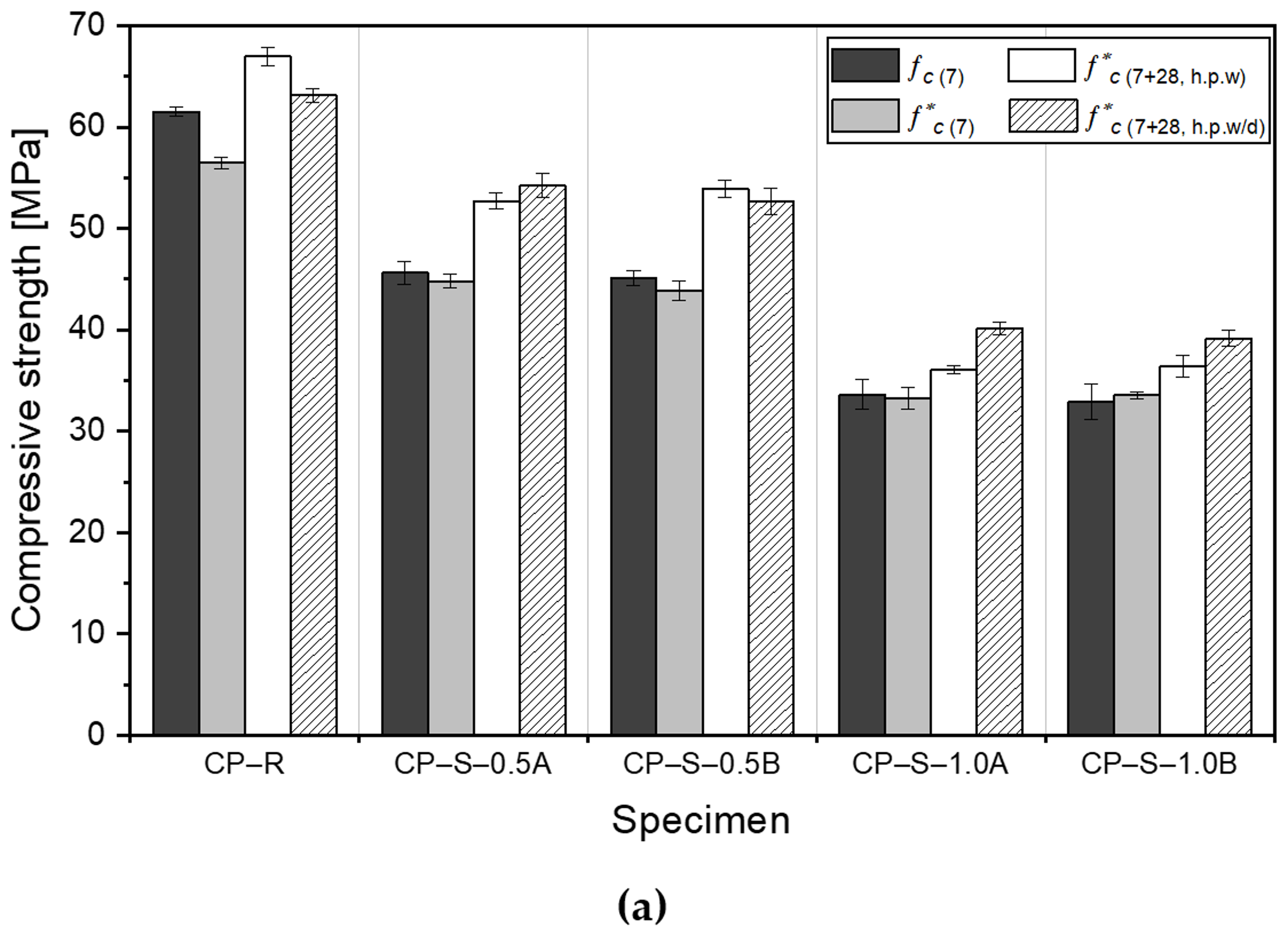
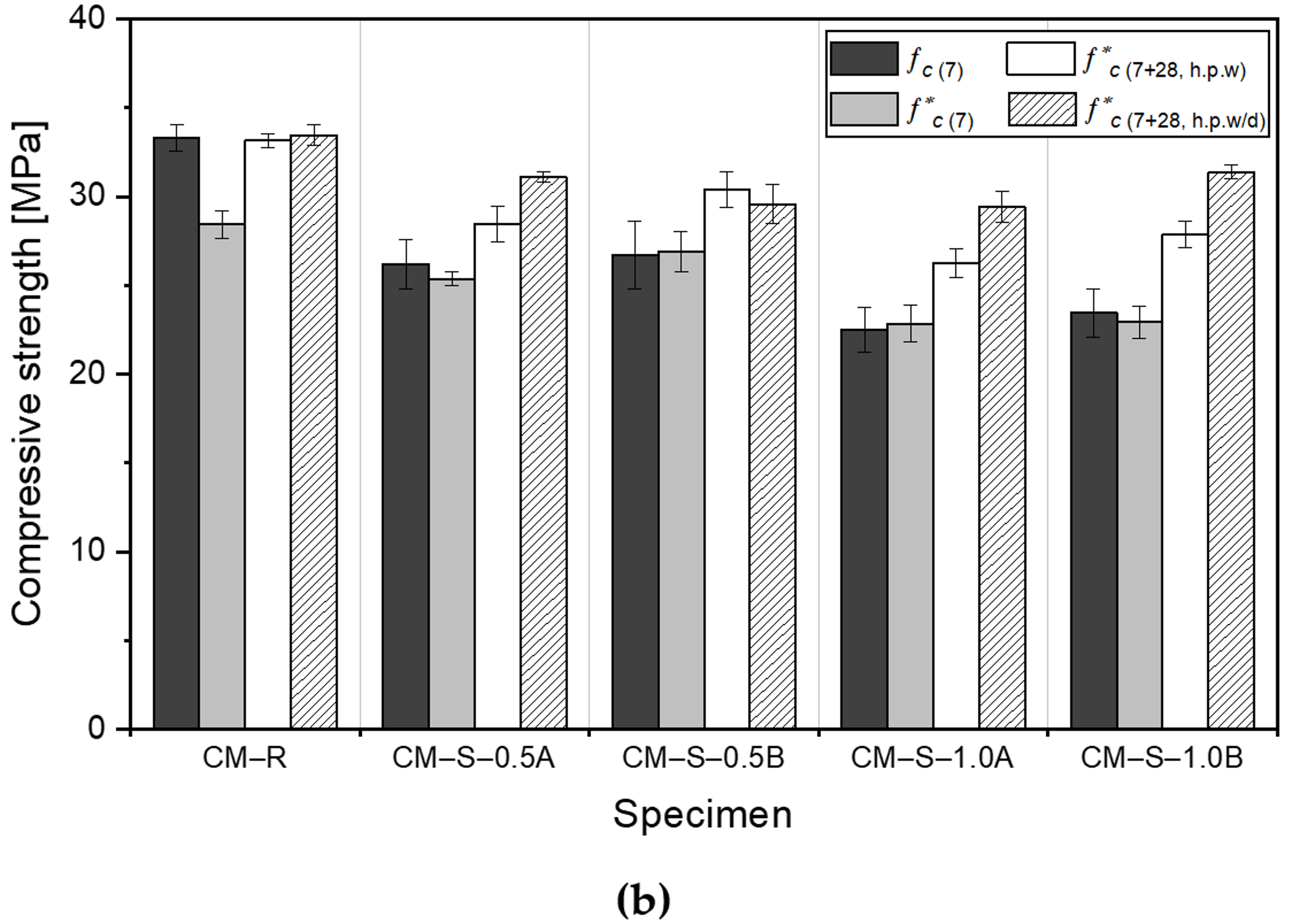

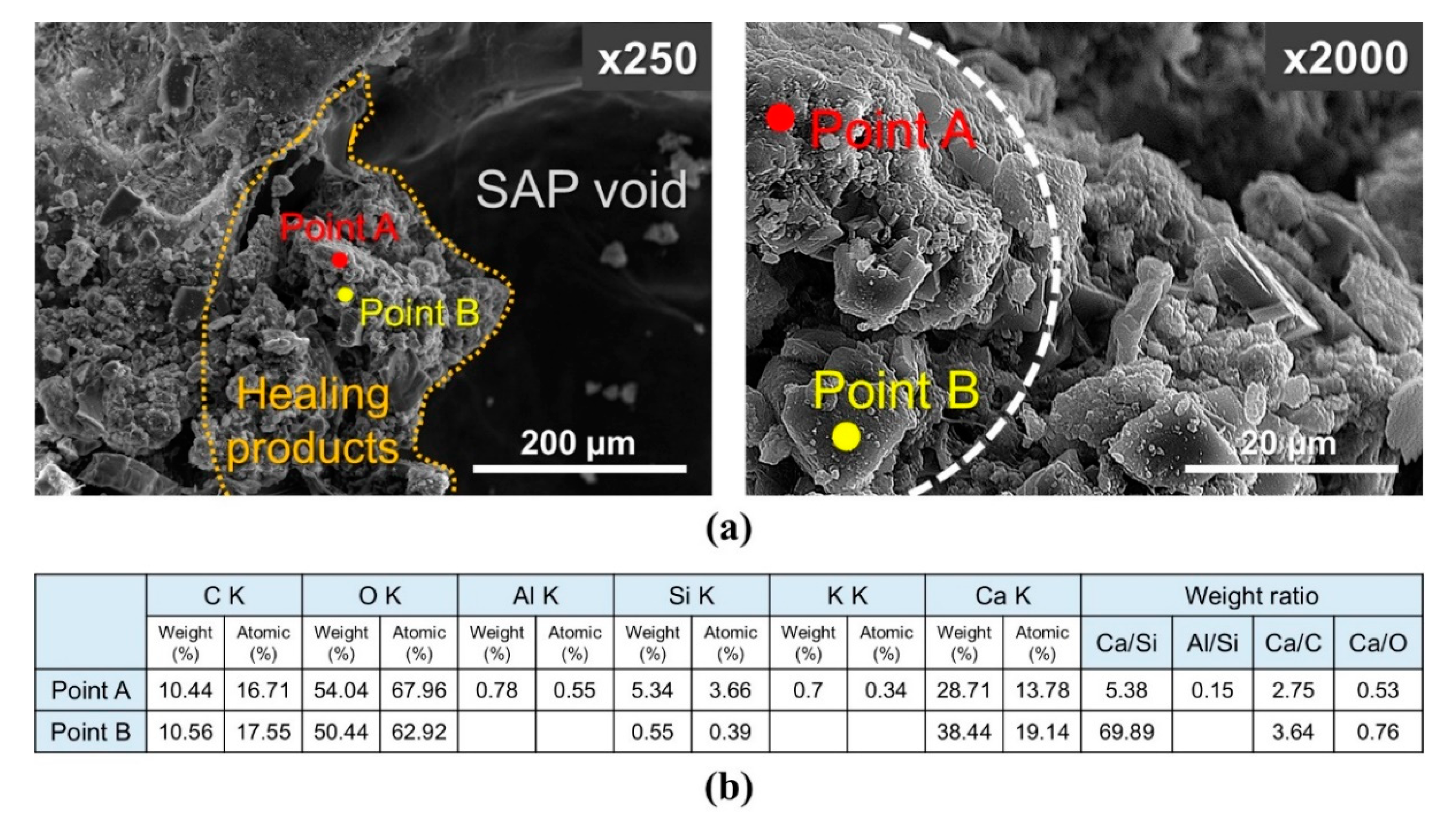
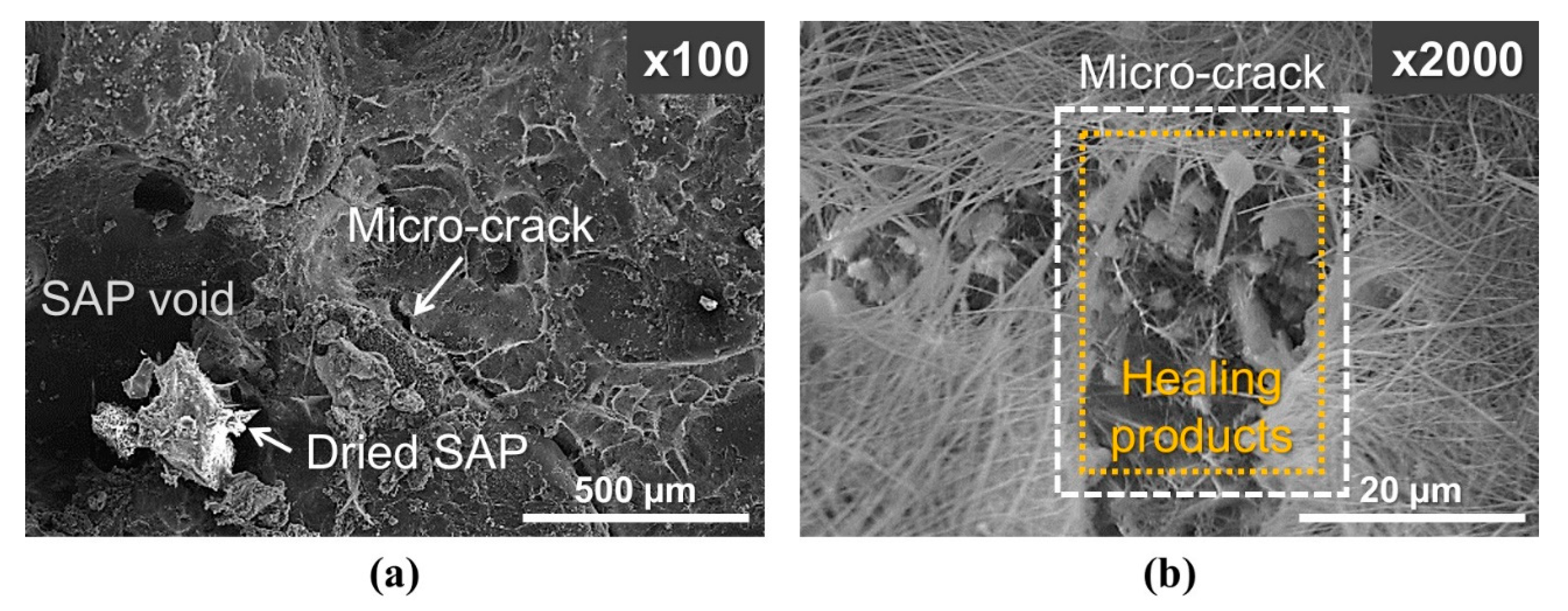

| SiO2 | Al2O3 | Fe2O3 | CaO | MgO | SO3 | K2O | Na2O | LOI 1 |
|---|---|---|---|---|---|---|---|---|
| 20.5 | 4.97 | 3.02 | 61.8 | 2.71 | 2.35 | 0.72 | 0.33 | 2.36 |
| Specimen | d% SAP 1 [wt.%] | Cement [kg/m3] | Sand [kg/m3] | SAP [kg/m3] | Water [kg/m3] | Water in SAP [kg/m3] | SP 4 [kg/m3] |
|---|---|---|---|---|---|---|---|
| CP–R | — | 1493.7 | — | — | 522.8 | — | — |
| CP–S–0.5A | 0.5 2 | 1384.1 | — | 6.9 | 484.4 | 69.2 | — |
| CP–S–1.0A | 1.0 2 | 1289.5 | — | 12.9 | 451.3 | 129.0 | — |
| CP–S–0.5B | 0.5 3 | 1384.1 | — | 6.9 | 484.4 | 69.2 | — |
| CP–S–1.0B | 1.0 3 | 1289.5 | — | 12.9 | 451.3 | 129.0 | — |
| CM–R | — | 750.4 | 1275.7 | — | 262.6 | — | 7.5 |
| CM–S–0.5A | 0.5 2 | 721.7 | 1226.9 | 3.6 | 252.6 | 36.1 | 7.2 |
| CM–S–1.0A | 1.0 2 | 695.1 | 1181.7 | 7.0 | 243.3 | 69.5 | 7.0 |
| CM–S–0.5B | 0.5 3 | 721.7 | 1226.9 | 3.6 | 252.6 | 36.1 | 7.2 |
| CM–S–1.0B | 1.0 3 | 695.1 | 1181.7 | 7.0 | 243.3 | 69.5 | 7.0 |
© 2020 by the authors. Licensee MDPI, Basel, Switzerland. This article is an open access article distributed under the terms and conditions of the Creative Commons Attribution (CC BY) license (http://creativecommons.org/licenses/by/4.0/).
Share and Cite
Hong, G.; Song, C.; Choi, S. Autogenous Healing of Early-Age Cracks in Cementitious Materials by Superabsorbent Polymers. Materials 2020, 13, 690. https://doi.org/10.3390/ma13030690
Hong G, Song C, Choi S. Autogenous Healing of Early-Age Cracks in Cementitious Materials by Superabsorbent Polymers. Materials. 2020; 13(3):690. https://doi.org/10.3390/ma13030690
Chicago/Turabian StyleHong, Geuntae, Chiwon Song, and Seongcheol Choi. 2020. "Autogenous Healing of Early-Age Cracks in Cementitious Materials by Superabsorbent Polymers" Materials 13, no. 3: 690. https://doi.org/10.3390/ma13030690





